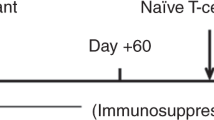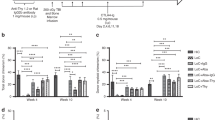Summary:
Cutaneous T-cell lymphomas (CTCL) are rare diseases that, in their advanced stages or in transformation, have a poor prognosis. Autologous stem cell transplantation (Au-SCT) after high-dose therapy has yielded disappointing results. Allogeneic transplantation (allo-SCT) provides the potential advantage of an immune-mediated graft-versus-lymphoma (GVL) effect. Reduced-intensity allo-SCT potentially offers a GVL effect, but with diminished toxicity related to the induction regimen; however, published experience with this approach in CTCL is limited. We report a series of three patients (age 35–49) with advanced, refractory (n=2) or transformed (n=1) CTCL who underwent reduced-intensity allo-SCT in the context of active disease. All three survived the peri-transplant period and, despite later having disease relapse, all exhibited evidence of a GVL effect. Relapses of the disease were in the context of immune suppression for graft-versus-host disease (GVHD), and when immune suppression was reduced, responses were regained. A comparison is made of these results to those in a review of the published literature to date. We conclude that while a GVL can be achieved for CTCL with reduced-intensity allogeneic transplantation, the clinical benefits are short lived and novel approaches are required to obtain sustained remissions.
This is a preview of subscription content, access via your institution
Access options
Subscribe to this journal
Receive 12 print issues and online access
$259.00 per year
only $21.58 per issue
Buy this article
- Purchase on Springer Link
- Instant access to full article PDF
Prices may be subject to local taxes which are calculated during checkout


Similar content being viewed by others
References
Willemze R, Kerl H, Sterry W et al. EORTC classification for primary cutaneous lymphomas: a proposal from the Cutaneous Lymphoma Study Group of the European Organization for Research and Treatment of Cancer. Blood 1997; 90: 354–371.
Kim YH, Hoppe RT . Mycosis fungoides and the Sezary syndrome. Semin Oncol 1999; 26: 276–289.
Kuzel TM, Roenigk Jr HH, Rosen ST . Mycosis fungoides and the Sezary syndrome: a review of pathogenesis, diagnosis, and therapy. J Clin Oncol 1991; 9: 1298–1313.
van Doorn R, Van Haselen CW, van Voorst Vader PC et al. Mycosis fungoides: disease evolution and prognosis of 309 Dutch patients. Arch Dermatol 2000; 136: 504–510.
Vergier B, de Muret A, Beylot-Barry M et al. Transformation of mycosis fungoides: clinicopathological and prognostic features of 45 cases. French Study Group of Cutaneous Lymphomas. Blood 2000; 95: 2212–2218.
Prince HM, McCormack C, Ryan G et al. Management of the primary cutaneous lymphomas. Australas J Dermatol 2003; 44: 227–240, quiz 241–242.
Lundin J, Hagberg H, Repp R et al. Phase 2 study of alemtuzumab (anti-CD52 monoclonal antibody) in patients with advanced mycosis fungoides/Sezary syndrome. Blood 2003; 101: 4267–4272.
Diamandidou E, Cohen PR, Kurzrock R . Mycosis fungoides and Sezary syndrome. Blood 1996; 88: 2385–2409.
Lazarus HCP, Ciobanu N . High dose BCNU, cisplatin, VP-16 with or without involved field radiotherapy (IFRT) and autologous bone marrow transplantation (AuBMT) for relapsed or refractory lymphoma. Blood 1989; 74 (Suppl. 1): 165a (abstract 617).
Sterling JC, Marcus R, Burrows NP, Roberts SO . Erythrodermic mycosis fungoides treated with total body irradiation and autologous bone marrow transplantation. Clin Exp Dermatol 1995; 20: 73–75.
Bigler RD, Crilley P, Micaily B et al. Autologous bone marrow transplantation for advanced stage mycosis fungoides. Bone Marrow Transplant 1991; 7: 133–137.
Ingen-Housz-Oro S, Bachelez H, Verola O et al. High-dose therapy and autologous stem cell transplantation in relapsing cutaneous lymphoma. Bone Marrow Transplant 2004; 33: 629–634.
Hansen ER . Immunoregulatory events in the skin of patients with cutaneous T-cell lymphoma. Arch Dermatol 1996; 132: 554–561.
Bladon J, Taylor PC . Extracorporeal photopheresis induces apoptosis in the lymphocytes of cutaneous T-cell lymphoma and graft-versus-host disease patients. Br J Haematol 1999; 107: 707–711.
Koeppel MC, Stoppa AM, Resbeut M et al. Mycosis fungoides and allogenic bone marrow transplantation. Acta Derm Venereol 1994; 74: 331–332.
Molina A, Nademanee A, Arber DA, Forman SJ . Remission of refractory Sezary syndrome after bone marrow transplantation from a matched unrelated donor. Biol Blood Marrow Transplant 1999; 5: 400–404.
Masood N, Russell KJ, Olerud JE et al. Induction of complete remission of advanced stage mycosis fungoides by allogeneic hematopoietic stem cell transplantation. J Am Acad Dermatol 2002; 47: 140–145.
Guitart J, Wickless SC, Oyama Y et al. Long-term remission after allogeneic hematopoietic stem cell transplantation for refractory cutaneous T-cell lymphoma. Arch Dermatol 2002; 138: 1359–1365.
Soligo D, Ibatici A, Berti E et al. Treatment of advanced mycosis fungoides by allogeneic stem-cell transplantation with a nonmyeloablative regimen. Bone Marrow Transplant 2003; 31: 663–666.
Molina AZJ, Arber M, Angelopoulou M et al. Is allogeneic hematopoietic stem cell transplantation (AHSCT) potentially curative in a group of refractory cutaneous T-cell lymphomas (CTCLs)? Durable clinical, cytogenetic and molecular remissions after AHSCT for refractory Sezary Syndrome and Mycosis Fungoides. Blood 2003; 102: 1737 [abstract].
Molina DA, Murata-Collins JL, Bernal A et al. Clinical, cytogenetic and molecular remissions after allogeneic hematopoietic stem cell transplantation for refractory Sezary syndrome and tumour-stage mycosis fungoides [abstract]. Blood 2001; 98 (part 1): 1715 [abstract].
Fijnheer R, Sanders CJ, Canninga MR et al. Complete remission of a radiochemotherapy-resistant cutaneous T-cell lymphoma with allogeneic non-myeloablative stem cell transplantation. Bone Marrow Transplant 2003; 32: 345–347.
Khouri IF, Keating M, Korbling M et al. Transplant-lite: induction of graft-versus-malignancy using fludarabine-based nonablative chemotherapy and allogeneic blood progenitor-cell transplantation as treatment for lymphoid malignancies. J Clin Oncol 1998; 16: 2817–2824.
Slavin S, Nagler A, Naparstek E et al. Nonmyeloablative stem cell transplantation and cell therapy as an alternative to conventional bone marrow transplantation with lethal cytoreduction for the treatment of malignant and nonmalignant hematologic diseases. Blood 1998; 91: 756–763.
Kantarjian HOBS, Beran M, Escudier S et al. Modified Burkitt regimen for adult acute lymphocytic leukemia (ALL)/The hyper-CVAD program. Blood 1993; 82 (suppl. 1): 329a.
Bierman PJ, Sweetenham JW, Loberiza Jr FR et al. Syngeneic hematopoietic stem-cell transplantation for non-Hodgkin's lymphoma: a comparison with allogeneic and autologous Transplantation – The Lymphoma Working Committee of the International Bone Marrow Transplant Registry and the European Group for Blood and Marrow Transplantation. J Clin Oncol 2003; 21: 3744–3753.
van Besien KW, de Lima M, Giralt SA et al. Management of lymphoma recurrence after allogeneic transplantation: the relevance of graft-versus-lymphoma effect. Bone Marrow Transplant 1997; 19: 977–982.
Robinson SP, Goldstone AH, Mackinnon S et al. Chemoresistant or aggressive lymphoma predicts for a poor outcome following reduced-intensity allogeneic progenitor cell transplantation: an analysis from the Lymphoma Working Party of the European Group for Blood and Bone Marrow Transplantation. Blood 2002; 100: 4310–4316.
Mandigers CM, Meijerink JP, Raemaekers JM et al. Graft-versus-lymphoma effect of donor leucocyte infusion shown by real-time quantitative PCR analysis of t(14;18). Lancet 1998; 352: 1522–1523.
Maloney DG, Molina AJ, Sahebi F et al. Allografting with nonmyeloablative conditioning following cytoreductive autografts for the treatment of patients with multiple myeloma. Blood 2003; 102: 3447–3454.
Kroger N, Schwerdtfeger R, Kiehl M et al. Autologous stem cell transplantation followed by a dose-reduced allograft induces high complete remission rate in multiple myeloma. Blood 2002; 100: 755–760.
Carella AM, Cavaliere M, Lerma E et al. Autografting followed by nonmyeloablative immunosuppressive chemotherapy and allogeneic peripheral-blood hematopoietic stem-cell transplantation as treatment of resistant Hodgkin's disease and non-Hodgkin's lymphoma. J Clin Oncol 2000; 18: 3918–3924.
Author information
Authors and Affiliations
Corresponding author
Rights and permissions
About this article
Cite this article
Herbert, K., Spencer, A., Grigg, A. et al. Graft-versus-lymphoma effect in refractory cutaneous T-cell lymphoma after reduced-intensity HLA-matched sibling allogeneic stem cell transplantation. Bone Marrow Transplant 34, 521–525 (2004). https://doi.org/10.1038/sj.bmt.1704641
Received:
Accepted:
Published:
Issue Date:
DOI: https://doi.org/10.1038/sj.bmt.1704641
Keywords
This article is cited by
-
Allogeneic transplantation in Cutaneous T-cell Lymphoma: improved outcomes associated with early transplantation and acute graft versus host disease
Bone Marrow Transplantation (2022)
-
Allogeneic hematopoietic stem cell transplantation for advanced mycosis fungoides and Sézary syndrome. An updated experience of the Lymphoma Working Party of the European Society for Blood and Marrow Transplantation
Bone Marrow Transplantation (2021)
-
Allogeneic hematopoietic stem cell transplantation in Primary Cutaneous T Cell Lymphoma
Annals of Hematology (2018)
-
Allogeneic hematopoietic stem cell transplantation for refractory mycosis fungoides (MF) and Sezary syndrome (SS)
International Journal of Hematology (2017)
-
Allogeneic hematopoietic cell transplantation for mycosis fungoides and Sezary syndrome
Bone Marrow Transplantation (2014)



